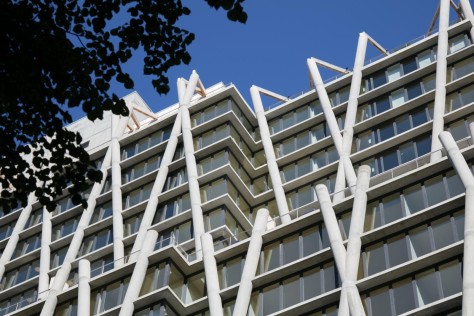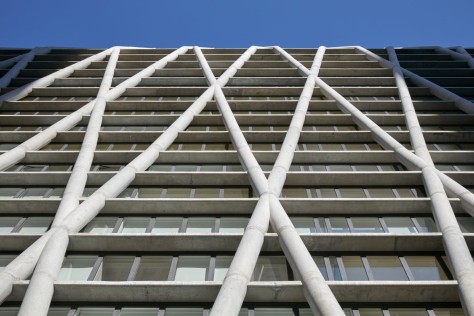
At a new terminus for West 68th Street, 170 Amsterdam sits between Central Park to the east and the landscaped open space of the Lincoln Towers superblock to the west. The building’s architecture is derived from its location between these large green spaces, providing the inspiration for the tree-like exoskeleton that defines the exterior.

The long narrow site demanded a solution that moves the structure to the outside of the enclosure in order to free up valuable interior space that would have been occupied by columns. The concrete exoskeleton is the result of a specialized mix that gives the appearance of limestone, a nod to the buildings Lincoln Square neighborhood.

170 Amsterdam affirms the creative possibilities that concrete affords by acting as both structure and finish. The diagonal columns that make up 170 Amsterdam’s exoskeleton intersect at different heights, giving the appearance of a façade in motion as the intersections rise to the top of the building. The deep recesses between the structure and the glass facade play with light and shadow, creating a changing impression throughout the day.

Once at the top, the skeleton continues up and over, forming a rooftop canopy. At ground level, the columns create a dynamic streetwall, with the structure angling into the sidewalk and piercing the building canopy. Inside, the exposed concrete columns intersect the public spaces of the building – the floors and walls of the lobby, common rooms and corridors – as they disappear into ceilings above.

By moving the structure to the outside, the architects created living units with a continuous wall of glass, uninterrupted by column bumps, and allowing for unobstructed living spaces within. In the apartments, seeing the structure through the floor-to-ceiling glass has the effect of being suspended in a treehouse. 170 Amsterdam is expected to be certified LEED Silver.

The horizontal projecting slab serves as a sun control device and contributes significantly to energy performance by reducing air–conditioning needs and lighting costs and providing glare-free natural light. The horizontal projecting slab/ sun control device provides 2.2% of the 10% energy cost reduction required by LEED. This building exemplifies the work of Handel Architects, where the possibilities of the site, context, and program reveal the building’s expression.

The muscular architecture of Lincoln Center and lower Amsterdam Avenue, the nearby ornate historic apartment buildings and the trees of Central Park all inspired the design. 170 Amsterdam is a catalyst for positive urban change in its appearance, services and functionality, consistent with the firm’s commitment to New York City’s social and economic development. Source by Handel Architects.

Location: 170 Amsterdam Avenue, New York, NY 10023, USA
Architects: Handel Architects
Structure: DeSimone Consulting Engineers
MEP/FP/Sustainability: ADS Consulting
Lighting: Clinard Design Studio
Zoning: Development Consulting Services
Exterior Wall: IBA Consulting & Engineering
Geotechnical/Civil: Langan Engineering
Code: Milrose Consultants
Acoustics: Shen Milsom Wilke
Vertical Transportation: VDA
Landscape: Blondie’s Treehouse
Concrete Consultant: Reginald Hough Associates
Construction Manager: Ryder Construction
Concrete Contractor: RC Structure
Formwork Contractor: Molded Fiber Glass CP
Furniture/Purchasing: L J Duffy
Art: Emily Santangelo Fine Art
Client: Equity Residential
Area: 21235.0 sqm
Year: 2015
Photographs: Bruce Damonte, Courtesy of The Iva Agency

